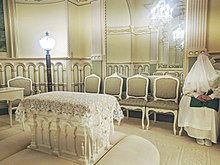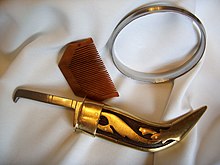Religious clothing
Ordained Buddhist bhikkus (monks) and bhikuunis (nuns) traditionally wear simple robes called kāṣāya, named after a brown or saffron dye used to give the fabric their distinctive non-primary colors.
Ordained Buddhists also keep their heads and faces shaved, often including eyebrows, as a symbol of the renunciation of worldly desires.
Vestments are liturgical garments and articles associated primarily with the Christian religions, especially Catholic, Eastern Orthodox, Anglicans, Methodists, and Lutheran Churches.
Our people are forbidden to appear in public with transparent or immodest apparel, including shorts or bathing suits.
Members believe that the wearing of these garments serves as a symbolic reminder of eternal covenants they have made with God the Father and Jesus Christ.
The clothing includes a robe that fits over one shoulder, a sash, an apron, a veil (for women), and a cap (for men).
[9] Outside of temples, including at weekly sacrament meetings and at general conferences, respectful clothing is traditionally worn, often with a white, button-down shirt, and a tie for the male members, females typically wear a dress or skirt, emphasizing "modesty" in appearance.
[citation needed] Tzitzit are specially knotted ritual fringes, or tassels worn by most Jewish men and boys during prayer.
Tzitzit are attached to the four corners of the tallit (Jewish prayer shawl) and in more traditional communities are tied to all four-cornered garments.
In the United States, most synagogues and Jewish funeral services keep a ready supply of kippot for the temporary use of visitors who have not brought one.
Kolpiks are worn by unmarried boys over bar mitzvah age who are from rabbinical families, and by certain Hasidic rabbis on special occasions that are more than a regular weekday but not warranting the wearing of a shtreimel, such as lighting Hanukkah candles and conducting a tish on Rosh Chodesh or Tu B'Shvat.
Bekishe coats or robes are worn by Hasidic lay men on Sabbath and holidays, both single and married.
The bekishe worn by certain rabbis may have colors other than black, such as white, silver, gold, or blue, and may also be lined with velvet.
The kittel is a white robe worn on certain occasions by married men (and some women)[14] in Ashkenazic and Hasidic communities, such as Yom Kippur and Passover Seder, and may be worn by those leading prayers (and in some communities by all married men) on Rosh Hashanah, Hoshanah Rabbah, and for Tefilas Tal and Tefilas Geshem.
In some Sephardic communities, a rabbi or a hazzan may wear a similar white robe at weddings and at prayer services.
[15] Wearing a thin red string (as a type of talisman) is a custom, popularly thought to be associated with Judaism's Kabbalah, in order to ward off misfortune brought about by an "evil eye" (עין הרע in Hebrew).
[16] The connection to traditional Judaism is disputed, and this is mostly worn by secular or non-Jewish spiritualist circles who often misunderstand the origins, or were sold manufactured versions within popular Israeli religious tourist attractions.
[17] Hindu men often don short coats known as angarkhas, while women typically wear long scarves or robes called saris.
Hair cutting, trimming, removing, shaving, plucking, threading, dyeing, or any other alteration from any body part is strictly forbidden.
[24] A Peace Mala is a symbolic bracelet used to promote the message of the Golden Rule of mutual respect recognised by many spiritual paths.
It consists of 16 beads, forming a double rainbow, which represent Christianity, Buddhism, Sikhism, Islam, Judaism, Baháʼí, ISKCON, Zoroastrianism, Tribal and Native Religions, Jainism, Earth Religions, Taoism, Hinduism and Yungdrung Bön, with the central white bead representing the wearer and whatever path they may follow.









